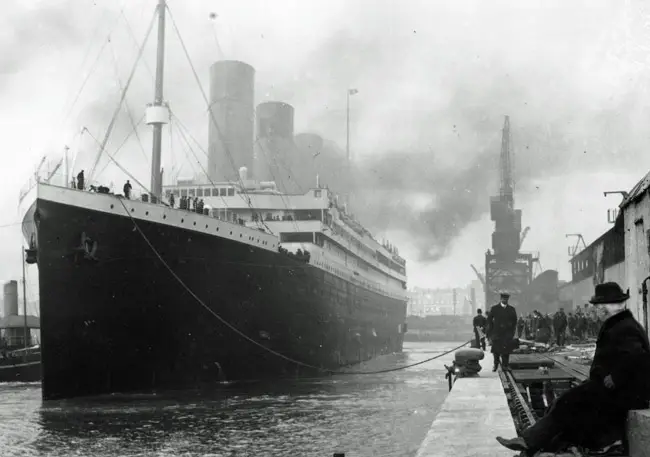
When “Titanic” sails into the Flagler Auditorium Tuesday, the musical won’t crash and sink, assures actor Sam Sherwood, who plays Charles Clark in the production. It will rise. Literally.
Director Paul Sloan starts things in reverse order, beginning with the sight of the shipwreck at the bottom of the ocean floor, the effect created by a deep wash of dark blue on the set, and the illusion of a ship resting at an angle. From there, as the overture finishes, through an innovative use of lights, audience members are treated to the spectacle of watching the ship, along with the ghosts of the souls on board, rise from the decay, back to what we can imagine to be their former glory. “It’s an extremely effective means of story-telling,” Sherwood says. In fairness to Clive Cussler, who raised the Titanic in his 1976 spy novel, it’s also a less mucky replay of that mostly forgotten thriller, though the musical is capitalizing a bit more on James Cameron’s colossal movie hit and, at least this year, the centennial of the ship’s fatal romance with a Newfoundland iceberg.
What separates the show from the 1997 movie is real life. “The great thing about our show is all the characters are actually based on real people who were on the Titanic,” Sherwood says, “particularly in the second and third classes, rather than just the upper classes. This is the primary story, not the fictional. Everyone knows how it ends, but now everyone gets to see how it actually began from the perspective of many of the souls on board.”

Set after set, song after (occasionally, inevitably hokey) song, the production is designed to recreate the voyage, with you on board. The play has changed some since its inception. On Broadway, the stage was much larger and grander. Now, as the production travels from locale to locale, it has to adapt to stages that are often smaller. This usually requires taking a simpler approach, one more focused on the story, though the music is unchanged.
“The score is really very incredible,” Sherwood says. “It’s very full and sweeping. For some songs we have the full company, which is just under 30 actors, singing on stage.” A small orchestra, creating sophisticated instrumentals that are woven throughout, enhances the story and underscores the dialogue, in subtle enough ways that at times you may not even notice it in the heat of the tragedy.
One powerful scene is not so much borrowed from the movie as from the one universal memory of the ship as it lists: That of the string quartet continuing to play as all else flails. Not to worry: the show isn’t nearly all gloom. There’s sap and tears, but there’s laughter too: it’s a musical, not “The Cherry Orchard.” The show also preserves its strange richness of statistical and documentary detail, told through the numerous characters and their various tax brackets.
Sherwood’s character, Charles Clark, is an English sports journalist engaged to Caroline Neville, who–naturally–comes from a much wealthier background. Her family doesn’t approve of the engagement so the two are fleeing to the United States to get married. The story isn;t that much different from Jack Dawson and Rose DeWitt Bukater’s romance in Cameron’s movie.
“The show is a lot about class differences,” Sherwood says. “When the ship hits the iceberg, class doesn’t matter anymore. We’re all the same.”
Sherwood, who became a part of the production this summer, has also played in “The Music Man” and “Ring of Fire,” the story of Johnny Cash, so he’s had his share of eclectic incarnations. Charles Clark is among the most personal, he says. “I’d been familiar with the story through the movie and my own reading, but this show brought my interest to another level,” he says. “I learned to appreciate what life was like afterwards in the United States for the survivors because of how grateful they must’ve been to make it. It is horribly sad to imagine what the real people went through.”
Asked how the show is still relevant to audiences today, Sherwood says the age-old lesson we learn from the Titanic is “hubris. It teaches us something about “the imperfection of humanity.”
The shipbuilders and financiers behind it, who included J. Pierpont Morgan, were eager to push limits and create the most luxurious, the biggest and fastest ship of its time. “Being so sure of themselves, they made a lot of errors. This was 100 years ago, but we can still learn these lessons in today’s world,” he says. “Back then technology was exploding like never before and we can say the same now. We need to be more humble.”
The Titanic, the largest ship in the world at the time, sank on April 14, 1912, on its maiden voyage from England to New York (after a stop in Cherbourg, in France), with an estimated 2,224 people aboard. Because there were not enough lifeboats, a problem compounded by the confusion of an inexperienced crew, some 1,517 passengers and crew perished. Just 706 survived. The casualties included most of the third class passengers, who, because of lower social status, were assigned the cabins in the lowest levels of the ship. The ship had received several warnings about icebergs. “Shut up,” the ship’s wireless operator had said shortly before the ship struck the iceberg. “I’m busy.”
In the end, beside the negligence of its crew, faulty rivets did the ship in.
While this tragedy resulted in establishment of safety standards for ocean liners, many similar types of tragedies still occur, also as a result of negligence, hubris or public pressures to proceed with projects despite the fact that safety protocols have not been met. One of the most memorable tragedies in the last quarter of a century, for example, captured live on television, was the 1986 explosion of the Challenger space shuttle, with a civilian teacher aboard. The launch took place after several days’ delay, while there were still problems that had not been resolved.
Much of what’s now known about the night of the Titanic sinking is the result of 17 days of Senate testimonies held at the Waldorf-Astoria Hotel just four days after ship’s demise, and survivors had reached New York. “There were a good few dead, sir,” one survivor, seaman Edward Buley, said. “Of course, you could not discern them exactly on account of the wreckage; but we turned over several of them to see if they were alive. It looked as though none of them were drowned. They looked as though they were frozen.”
“They were head and shoulders out of the water?,” Duncan Fletcher, a Florida senator, asked him.
“Yes, sir.”
“They were not, apparently, drowned?”
“It looked as though they were frozen altogether, sir.”
![]()
“Titanic” is in performance for one night only, Nov. 13 at 7:30 p.m. at the Flagler Auditorium. Tickets are $42 for adults, $28 for youths. Call the Auditorium box office at 437-7547.




























Leave a Reply